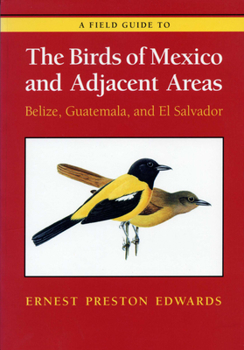A Field Guide to the Birds of Mexico and Adjacent Areas: Belize, Guatemala, and El Salvador, Third Edition
Select Format
Select Condition 
Book Overview
More than a thousand species of birds occur in Mexico and in the adjacent countries of Belize, Guatemala, and El Salvador. Of these birds, a unique mixture of temperate-zone and tropical species, less than half are found in the United States, and many cross the border only a short distance into the southwestern states. This practical field guide contains detailed annotations for easy identification of all of Mexico's regular species. The...
Format:Paperback
Language:English
ISBN:0292720912
ISBN13:9780292720916
Release Date:July 1998
Publisher:University of Texas Press
Length:292 Pages
Weight:1.00 lbs.
Dimensions:0.8" x 5.8" x 8.3"
Customer Reviews
5 ratings
Great books- wonderful illustrations
Published by Thriftbooks.com User , 15 years ago
This book has a nice variety of birds from the Latin America(Mexico, etc) regions. Very nice illustrations of the birds in the areas and easy to look up species.
a useful supplement
Published by Thriftbooks.com User , 16 years ago
Before Howell published his guide to Mexican birding locations birders relied on the self-published bird-finding guide (and supplements) by Ernest P. Edwards. In fact, I rarely travel south of the border without at least reading from those works; the places have changed (often dramatically), but you still get a feel for a place (and its history). Edwards also published a quite compact field guide, and this guide (from the University of Texas Press) is a worthy successor. Few birders would make the trip to Mexico without the encyclopedic Howell & Webb guide, and many even separate the plates from the text for a much more portable field resource. The Peterson-Chalif guide is a good second reference for some, but quite honestly I prefer Edwards. He gets a lot of species on a plate, and that often helps when one is narrowing down choices. The illustrations are good and they're almost all in color (the exceptions being two plates of seabirds and other waterbirds, all rendered in North American guides), and he includes illustrations of many birds also found in North American field guides (unlike Person-Chalif) I will concede that the sequence of illustrations can be confusing at times; see (for example) Plate 45 (with sparrows, an oriole, plovers, seabirds, a Chachalaca, and the Imperial Woodpecker) and Plate 48 (portraying southeastern specialties, including a rail, hummingbirds, a quail, a woodcreeper, antbirds, flycatchers, and a seedeater, among others). It can be frustrating at times, but once you've used the guide a few times it really isn't that much of an impediment. For many birders traveling to Mexico (or Belize, Guatemala, and El Salvador) this won't be a primary reference, but it is a quite useful supplement at a reasonable price. And it's from someone who helped blaze the trail for the rest of us!
Nice pictures, but disorganized
Published by Thriftbooks.com User , 23 years ago
This book has what Peterson's "Mexican Birds" lacks: good colour pictures of (nearly) all birds of Mexico and adjacent areas and their Spanish names. However, the presentation of the pictures is a mishmash. The descriptions of the birds are not detailed but very short. It is a pity that there is no information about the behaviour of the birds, often very important for identification.
Birding in Belize
Published by Thriftbooks.com User , 25 years ago
We used this book on a recent trip to Belize. It is THE book in use by local Belizian birding enthusiasts, and we only saw it for sale at one shop during our 12 day stay, so it might be hard to get once you're there. Birds of same species on different color plates slow you down, but the pictures are very good. Highly recommend taking this book with you if you plan to do any serious birdwatching.
A great book with a pesky fault
Published by Thriftbooks.com User , 25 years ago
This field guide will enable you to see paintings of all of the birds that occur in the area. It also discusses (briefly) each bird. The paintings are excellent and the copy is quick and to the point. To pick at nits, though, the arrangement of the paintings is confusing. Not all birds in a specific family are illustrated on the same plate, and some are found pages away from the rest of their family. The logic seems to be that if the bird is found regularly in northern North America (the elegant trogon, for example) its picture does not need to run with the rest of its relatives. Close study of the guide can overcome this problem, however, making it an easy, economical way to pack the information of other guides into the field.





